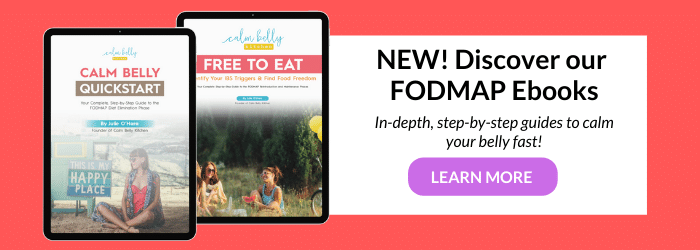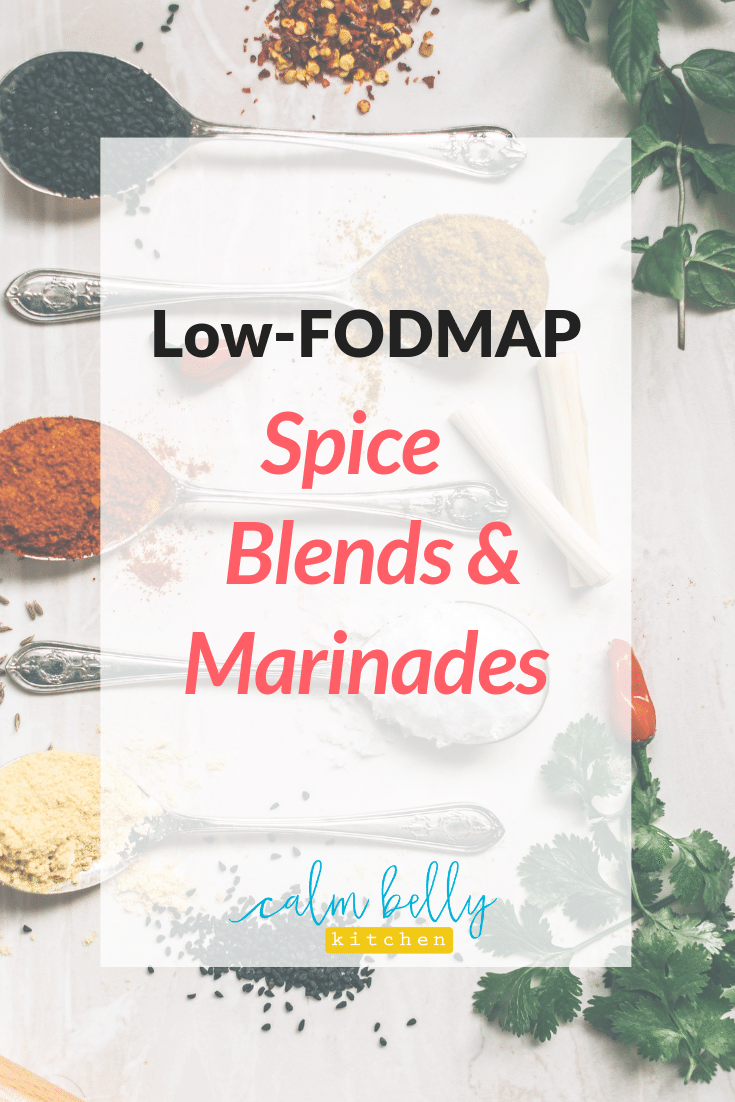Save it on Pinterest!
If you're a vegetarian or vegan who just learned about the FODMAP Diet (the diet that shows you how to manage IBS symptoms), you might be freaking out right about now.
Why? The FODMAP Diet requires that you eliminate most legumes, a huge variety of fruit and vegetables, not to mention wheat and certain nuts. So what's left for you if eating meat isn't really your style?
Never fear, veggie lovers, this post is your getting started guide. You'll learn:
What to do first
How to create delicious meals with variety so you don't die of boredom
The best (meatless) protein options
Watch the video get all the tasty details, or keep reading for the key points (and a bunch of great resources!)...
Getting Started with FODMAP as a Vegetarian or Vegan
What To Do First
Here's my general advice for approaching the FODMAP diet as a vegan or vegetarian: Instead of diving right in, spend a week or two learning the ins and outs of the diet. Get the Monash app (the most reliable, up-to-date reference) so you know the foods and serving sizes you should be eating.
>>> IF YOU DO JUST ONE THING: Go through the app and make a list of all the foods you CAN eat and then start building your meals around those.
Meal Planning Without Boredom
When you're coming up with meal ideas, focus on meals you can play around with. That way, you can have a handful of different meals made with the same core ingredients to create a FODMAP meal plan that works for you.
For example, if you eat quinoa or brown rice, you can combine that with your choice of low-FODMAP veggies like zucchini, tomatoes, salad greens, bell peppers, carrots, etc. You can roast, saute, or steam them.
Then you can add olives, cheese, nuts, seeds, sun-dried tomatoes, tempeh, avocado, canned lentils, canned chickpeas, hot sauce if that's your thing. Just check your serving sizes, and you'll discover more variety than you think!
>>> TIP: Small amounts of canned lentils and chickpeas, as well as red lentils, are low-FODMAP. Check the Monash app so you're sticking to the correct serving size (too large a serving and you cross over into the high-FODMAP range). You can eat these legumes more than once a day - just space them about 3 to 4 hours apart.
Use different herbs and spices to create different flavor profiles. For example, you can have a curry bowl one day and a Mexican-style bowl (avocado, ancho chile powder, cilantro) the next day.
Think about soups you can create with this method. Gluten free pasta and risotto are two more foods that can be prepared with different ingredients every time.
Your Top Protein Options:
You could probably guess this one: tofu and tempeh. Soft, firm and extra firm tofu are low-FODMAP.
Silken tofu is processed differently and retains some of the liquid from the pressed soybeans where those FODMAPs are found, so avoid the silken variety.
With tempeh you're in the clear. Although it's made from whole soybeans, the fermentation process reduces FODMAP content. Just be sure to check the ingredients if you're buying tempeh that's already seasoned. The best bet is to buy it plain and dress it up yourself. Tempeh contains even more protein than tofu.
Cooking tempeh and tofu:
Tempeh has great earthy flavor on it's own, but you can dress it up any way you like. I usually cut it into cubes and sear it in a pan with with a little stir fry sauce made with tamari, lime and sugar.
When it comes to tofu, try baking it. It gives it a satisfying texture, and you can do a big batch to use for several days. Here are some recipe ideas and cooking instructions for both:
Get to Know Tempeh
Recipe: Tempeh with Charred Peppers and Kale
-Omit onion; add more bell pepper or carrot if desired; add scallion tops
Calm Belly Kitchen: Brown Rice Noodle and Veggie Stir Fry
-Replace Shrimp with Tempeh
Monash Blog: Tofu Scramble Recipe
How to Make Baked Tofu
Remember This, Veggie Lovers!
Finally, remember that it's temporary. You do the elimination phase to confirm your FODMAP sensitivity. Then if it does improve your symptoms, you slowly bring back high-FODMAP foods. You'll learn your tolerance levels so you can have a lot more variety and flexibility in your diet.
More FODMAP Diet Plan Resources for Vegetarians and Vegans
http://thefodmapfriendlyvegan.com/product/fodmap-friendly-vegan-ebook/
https://www.amazon.com/Low-Fodmap-Vegan-What-When-Anything/dp/1570673373/
A very helpful resource for vegan menu planning I found through Kate Scarlata's website: http://blog.katescarlata.com/wp-content/uploads/2014/10/Vegan-Menu-Planning-Low-FODMAP.pdf
I do have one vegan recipe on my website, and I love it. It's great as leftovers too: https://calmbellykitchen.com/blog/vegan-nut-loaf-low-fodmap-gluten-free
More meal and recipe ideas:
Monash Blog: Eating Vegan on a Low-FODMAP Diet
Meat Free Meals the Low-FODMAP Way by Stephanie Clairmont, RD












